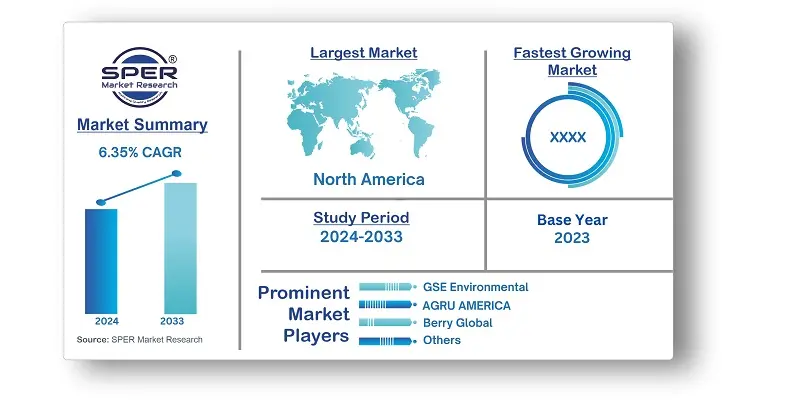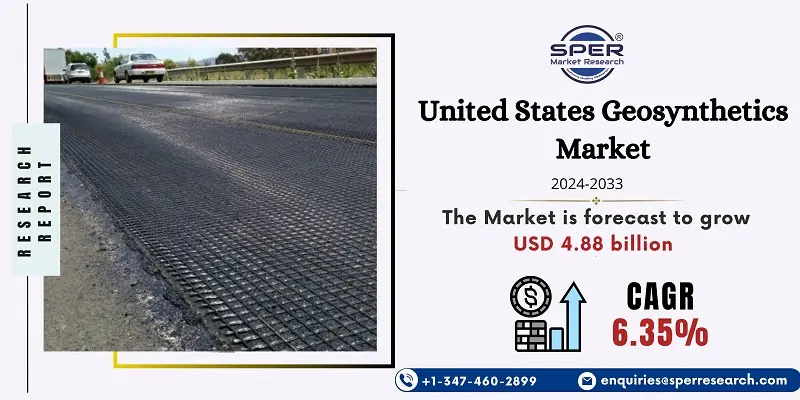
United States Geosynthetics Market Growth, Size, Trends, Demand, Revenue and Future Outlook
United States Geosynthetics Market Size- By Product, By Type, By Material, By Application- Regional Outlook, Competitive Strategies and Segment Forecast to 2033
| Published: May-2024 | Report ID: CHEM2452 | Pages: 1 - 102 | Formats*: |
| Category : Chemical & Materials | |||
- In January 2024, NAUE GmbH & Co. KG introduced Geosynthetics in the ChatGPT shop. It is the first geosynthetics company to integrate unique solutions into the ChatGPT store: Geosynthetics GPT bot. The tool was designed to combine geotechnical engineering expertise with ChatGPT's artificial intelligence capabilities.
- HUESKER Group collaborated with ABB, a robotics and automation pioneer, to introduce its first high-performance robot in September 2021. The gadget can handle and palletize heavy yarn reels. The automation of this procedure will allow the company to accelerate the production of high-performance fabrics.


| Report Metric | Details |
| Market size available for years | 2020-2033 |
| Base year considered | 2023 |
| Forecast period | 2024-2033 |
| Segments covered | By Product, By Type, By Material, By Application |
| Regions covered | West United States, East United States, North United States, South United States |
| Companies Covered | GSE Environmental, Texel Technical Materials, Inc, SKAPS Industries, Fibertex Nonwoven A/S, Tensar International Corporation, HUESKER, Strata Systems, Inc, AGRU AMERICA, INC, Berry Global, Inc, Nilex Inc, Maccaferri Inc. |
- Agricultural Sector
- Architects and Landscape Designers
- Civil Engineers and Construction Companies
- Environmental Engineers
- Government Agencies and Municipalities
- Manufacturers and Suppliers of Geosynthetics
- Mining Industry
- Oil and Gas Industry
- Research and Academic Institutions
| By Product: |
|
| By Type: |
|
| By Material: |
|
| By Application: |
|
- United States Geosynthetics Market Size (FY’2024-FY’2033)
- Overview of United States Geosynthetics Market
- Segmentation of United States Geosynthetics Market By Product (Geotextiles, Geomembranes, Geogrids, Geocells, Geonets, Geosynthetic Clay Liner, Pre-Fabricated Vertical Drains, Others)
- Segmentation of United States Geosynthetics Market By Type (Woven, Non-Woven, Knitted, Others)
- Segmentation of United States Geosynthetics Market By Material (Polypropylene, Polyester, Polyethylene, Polyvinyl Chloride, Synthetic Rubber, Others)
- Segmentation of United States Geosynthetics Market By Application (Road Construction and Pavement Repair, Railroads, Drainage Systems, Soil Reinforcement and Erosion, Water and Waste Management, Others)
- Statistical Snap of United States Geosynthetics Market
- Expansion Analysis of United States Geosynthetics Market
- Problems and Obstacles in United States Geosynthetics Market
- Competitive Landscape in the United States Geosynthetics Market
- Impact of COVID-19 and Demonetization on United States Geosynthetics Market
- Details on Current Investment in United States Geosynthetics Market
- Competitive Analysis of United States Geosynthetics Market
- Prominent Players in the United States Geosynthetics Market
- SWOT Analysis of United States Geosynthetics Market
- United States Geosynthetics Market Future Outlook and Projections (FY’2024-FY’2033)
- Recommendations from Analyst
1.1. Scope of the report1.2. Market segment analysis
2.1. Research data source2.1.1. Secondary Data2.1.2. Primary Data2.1.3. SPER’s internal database2.1.4. Premium insight from KOL’s2.2. Market size estimation2.2.1. Top-down and Bottom-up approach2.3. Data triangulation
4.1. Driver, Restraint, Opportunity and Challenges analysis4.1.1. Drivers4.1.2. Restraints4.1.3. Opportunities4.1.4. Challenges4.2. COVID-19 Impacts of the United States Geosynthetics Market.
5.1. SWOT Analysis5.1.1. Strengths5.1.2. Weaknesses5.1.3. Opportunities5.1.4. Threats5.2. PESTEL Analysis5.2.1. Political Landscape5.2.2. Economic Landscape5.2.3. Social Landscape5.2.4. Technological Landscape5.2.5. Environmental Landscape5.2.6. Legal Landscape5.3. PORTER’s Five Forces5.3.1. Bargaining power of suppliers5.3.2. Bargaining power of buyers5.3.3. Threat of Substitute5.3.4. Threat of new entrant5.3.5. Competitive rivalry5.4. Heat Map Analysis
6.1. United States Geosynthetics Market Manufacturing Base Distribution, Sales Area, Product Type6.2. Mergers & Acquisitions, Partnerships, Product Launch, and Collaboration in United States Geosynthetics Market
7.1. United States Geosynthetics Market Size, Share and Forecast, By Product, 2020-20267.2. United States Geosynthetics Market Size, Share and Forecast, By Product, 2027-20337.3. Geotextiles7.4. Geomembranes7.5. Geogrids7.6. Geonets7.7. Geosynthetic Clay Liner (GCL)7.8. Pre-Fabricated Vertical Drains (PVD)
7.9. Others
8.1. United States Geosynthetics Market Size, Share and Forecast, By Type, 2020-20268.2. United States Geosynthetics Market Size, Share and Forecast, By Type, 2027-20338.3. Woven8.4. Non-Woven8.5. Knitted
8.6. Others
9.1. United States Geosynthetics Market Size, Share and Forecast, By Material, 2020-20269.2. United States Geosynthetics Market Size, Share and Forecast, By Material, 2027-20339.3. Polypropylene9.4. Polyester9.5. Polyethylene9.6. Polyvinyl Chloride9.7. Synthetic Rubber9.8. Others
10.1. United States Geosynthetics Market Size, Share and Forecast, By Application, 2020-202610.2. United States Geosynthetics Market Size, Share and Forecast, By Application, 2027-203310.3. Road Construction and Pavement Repair10.4. Railroads10.5. Drainage Systems10.6. Soil Reinforcement and Erosion10.7. Water and Waste Management
10.8. Others
11.1. United States Geosynthetics Market Size and Market Share
12.1. United States Geosynthetics Market Size and Market Share By Region (2020-2026)12.2. United States Geosynthetics Market Size and Market Share By Region (2027-2033)12.3. West United States12.4. East United States12.5. North United States12.6. South United States
13.1. GSE Environmental13.1.1. Company details13.1.2. Financial outlook13.1.3. Product summary13.1.4. Recent developments13.2. Texel Technical Materials, Inc13.2.1. Company details13.2.2. Financial outlook13.2.3. Product summary13.2.4. Recent developments13.3. SKAPS Industries13.3.1. Company details13.3.2. Financial outlook13.3.3. Product summary13.3.4. Recent developments13.4. Fibertex Nonwoven A/S13.4.1. Company details13.4.2. Financial outlook13.4.3. Product summary13.4.4. Recent developments13.5. Tensar International Corporation13.5.1. Company details13.5.2. Financial outlook13.5.3. Product summary13.5.4. Recent developments13.6. HUESKER13.6.1. Company details13.6.2. Financial outlook13.6.3. Product summary13.6.4. Recent developments13.7. Strata Systems, Inc13.7.1. Company details13.7.2. Financial outlook13.7.3. Product summary13.7.4. Recent developments13.8. AGRU AMERICA, INC13.8.1. Company details13.8.2. Financial outlook13.8.3. Product summary13.8.4. Recent developments13.9. Berry Global, Inc13.9.1. Company details13.9.2. Financial outlook13.9.3. Product summary13.9.4. Recent developments13.10. Nilex Inc13.10.1. Company details13.10.2. Financial outlook13.10.3. Product summary13.10.4. Recent developments13.11. Maccaferri Inc13.11.1. Company details13.11.2. Financial outlook13.11.3. Product summary13.11.4. Recent developments13.12. Others
SPER Market Research’s methodology uses great emphasis on primary research to ensure that the market intelligence insights are up to date, reliable and accurate. Primary interviews are done with players involved in each phase of a supply chain to analyze the market forecasting. The secondary research method is used to help you fully understand how the future markets and the spending patterns look likes.
The report is based on in-depth qualitative and quantitative analysis of the Product Market. The quantitative analysis involves the application of various projection and sampling techniques. The qualitative analysis involves primary interviews, surveys, and vendor briefings. The data gathered as a result of these processes are validated through experts opinion. Our research methodology entails an ideal mixture of primary and secondary initiatives.



Frequently Asked Questions About This Report
PLACE AN ORDER
Year End Discount
Sample Report
Pre-Purchase Inquiry
NEED CUSTOMIZATION?
Request CustomizationCALL OR EMAIL US
100% Secure Payment






Related Reports
Our Global Clients
Our data-driven insights have influenced the strategy of 200+ reputed companies across the globe.




















